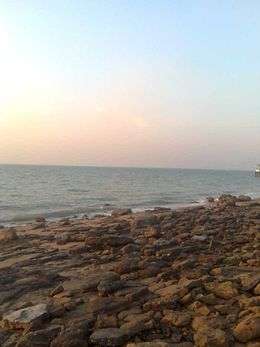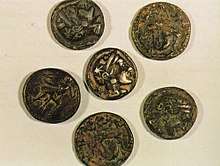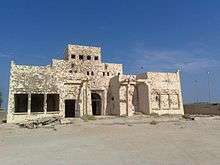Failaka Island
Failaka Island (Arabic: فيلكا Faylakah / Fēlaka ; Kuwaiti Arabic: فيلچا /fe:lɪt͡ʃə/) is a Kuwaiti Island in the Arabian Gulf. The island is 20 km off the coast of Kuwait City in the Arabian Gulf. The name "Failaka" is thought to be derived from the ancient Greek φυλάκιο(ν) - fylakio(n) "outpost".[2]
 Beach at Failaka Island | |
 Failaka Island جزيرة فيلكا Location in Kuwait | |
| Geography | |
|---|---|
| Location | Arabian Gulf |
| Coordinates | 29°26′20″N 48°20′00″E |
| Administration | |
| Province | Ahmadi Governorate |
| Demographics | |
| Population | 147 (2011)[1] |
History
In 2000 B.C., Mesopotamians settled in Failaka at least a century before the Dilmun civilization.[3] Traders from the Sumerian city of Ur occupied Failaka and ran a mercantile business.[3] Failaka had many Mesopotamian-style buildings typical of those found in Iraq dating from around 2000 B.C.[3]
Starting in the 3rd millennium BC, Failaka belonged to the Dilmun civilization.[4] During the Dilmun era (from ca. 3000 BC), Failaka was known as "Agarum", the land of Enzak, a great god in the Dilmun civilization according to Sumerian cuneiform texts found on the island.[4] As part of Dilmun, Failaka became a hub for the civilization from the end of the 3rd to the middle of the 1st millennium BC.[4] Failaka was settled following 2000 BC after a drop in sea level.[5]
After the Dilmun civilization, Failaka was inhabited by the Kassites of Mesopotamia,[6] and was formally under the control of the Kassite dynasty of Babylon.[6] Studies indicate traces of human settlement can be found on Failaka dating back to as early as the end of the 3rd millennium BC, and extending until the 20th century AD.[4] Many of the artifacts found in Falaika are linked to Mesopotamian civilizations and seem to show that Failaka was gradually drawn toward the civilization based in Antioch.[7]
Under Nebuchadnezzar II, Failaka was under Babylonian control.[8] Cuneiform documents found in Failaka indicate the presence of Babylonians in the island's population.[9] Babylonian Kings were present in Failaka during the Neo-Babylonian Empire period, Nabonidus had a governor in Failaka and Nebuchadnezzar II had a palace and temple in Falaika.[10][11] Failaka also contained temples dedicated to the worship of Shamash, the Mesopotamian sun god in the Babylonian pantheon.[11]
At some point following Alexander's initial advance through the region in 331 BC or in the period 324/3 BC when he returned to Mesopotamia, the ancient Greeks colonized the island, which they named Ikaros after the Greek island in the Aegean Sea and the mythical hero Icarus, apparently in the belief that the island had a similar shape of its Aegean counterpart. Some elements of Greek mythology were mixed with the local cults.[12] "Ikaros" was also the name of a prominent city situated in Failaka.[13] Remains of the settlement include a large Hellenistic fort and two Greek temples.[14]

In 127 BC, the kingdom of Characene was established around the Bay of Kuwait near Failaka. Characene was centered in the region encompassing southern Mesopotamia,[15] including Failaka island.[16] A busy commercial station existed on Failaka island.[17]
A Christian Nestorian settlement flourished in Failaka from the 5th century until the 9th century.[18] Excavations have revealed several farms, villages and two large churches dating from the 5th and 6th century.[18] Archaeologists are currently excavating nearby sites to understand the extent of the settlements that flourished in the eighth and ninth centuries A.D.[18] An old island tradition is that a community grew up around a Christian mystic and hermit.[18] The small farms and villages were eventually abandoned.[18] Remains of Byzantine era Nestorian churches were found at Al-Qusur in Failaka. Pottery at the site can be dated from as early as the first half of the 7th century through the 9th century.[19][20]
Prior to the Iraqi Invasion, the island had over two thousand residents and several schools. The village of Al-Zawr is situated near the middle of the northwest side of the island. It was the longest continuously inhabited location in Kuwait. During 1990 and 1991, the invading Iraqis depopulated the island, expelling all of its residents to the mainland. The Iraqi military mined the beaches and used the island's facilities and buildings for target practice. In 1991, the allied forces forced the Iraqi army forces occupying the island to surrender through bombing and psywar operations.[21] The sewage system was destroyed and has yet to be fully repaired. Also, many old homes continue to sit empty and decaying; bullet holes can still be seen.

After the war, Failaka was cleared of mines, but it remains under military use. Nevertheless, Failaka Island is becoming a popular holiday destination from Kuwait City. The ferry Ikarus takes passengers out to the island. Currently, the ferry terminal is located in Salmiya's Marina.
Climate, geography and the future
Failaka Island is located in the northern part of the Persian Gulf. Springtime on Failaka Island is regarded as particularly special by Kuwaitis. Failaka has quite a different ecosystem to mainland Kuwait, and its budding flowers and changing temperatures are much appreciated. Although the island's infrastructure remains poor, Failaka is beginning to develop a local tourist industry; it provides fishing, boating, swimming, sailing and water sports.
The few remaining local residents are mostly those Failakawans who lived with their families on the island prior to the Iraqi Invasion of 1990. Most Failakawans have their own boats and some are involved in tourism, but many are reticent about letting tourism detract from the quiet island life. Some Failakawan families, although now living in mainland Kuwait, regularly go to the island on weekends.
On the mainland, in Kuwait City, there have been various schemes to build a bridge to the island and make it a vacation paradise, as has been done in Bahrain. A new hotel resort has encouraged many of the improvements.
Archaeology
Failaka is the principal center of archaeology in Kuwait. Since the fieldwork conducted by the Danish team under the supervision of Geoffrey Bibby in the 1950s, archaeologists from France, the United States, Slovakia, Italy, Greece, and, more recently, from Poland and Georgia have worked there.[12][22]
Notes
- "Geoportal for Kuwait Census 2011". Central Statistical Bureau of Kuwait. Retrieved 26 November 2019.
- BBC News article
- "Traders from Ur?". Archaeology Magazine. Retrieved 28 August 2013.
- "Sa'ad and Sae'ed Area in Failaka Island". UNESCO. Retrieved 28 August 2013.
- Potts, Daniel T.. Mesopotamian civilization: the material foundations. 1997
- Potts, D.T. (2009). "Potts 2009 - The archaeology and early history of the Persian Gulf": 35. Cite journal requires
|journal=(help) - Tétreault, Mary Ann. "Failaka Island: Unearthing the Past in Kuwait". Middle East Institute. Retrieved 21 July 2013.
- "Brill's New Pauly: encyclopedia of the ancient world". 2007. p. 212.
- "The Archaeology of Seafaring in Ancient South Asia". Himanshu Prabha Ray. 2003. p. 101.
- "From Cyrus to Alexander: A History of the Persian Empire". Pierre Briant. 2002. p. 761.
- "The Routledge Handbook of the Peoples and Places of Ancient Western Asia". Trevor Bryce. 2009. p. 198.
- Αρχαιολογία: Ελληνες στο Κουβέιτ (in Greek)
- J. Hansamans, Charax and the Karkhen, Iranica Antiquitua 7 (1967) page 21-58
- George Fadlo Hourani, John Carswell, Arab Seafaring: In the Indian Ocean in Ancient and Early Medieval Times Princeton University Press, page 131
- Kaveh Farrokh (2007). Shadows in the Desert: Ancient Persia at War. p. 124.
With Babylon and Seleucia secured, Mehrdad turned to Charax in southern Mesopotamia (modern south Iraq and Kuwait).
- "Hellenism in the East" (PDF). Amelie Kuhrt, Susan Sherwin-White. 1987.
To the south of Characene, on Failaka, the north wall of the fort was pushed forward, before occupation ceased around 100 BC.
- Leonardo Gregoratti. "A Parthian Harbour in the Gulf: the Characene". p. 216.
- "Hidden Christian Community". Archaeology Magazine. Retrieved 28 August 2013.
- Vincent Bernard and Jean Francois Salles, "Discovery of a Christian Church at Al-Qusur, Failaka (Kuwait)," Proceedings of the Seminar for Arabian Studies 21 (1991), 7–21. Vincent Bernard, Olivier Callot and Jean Francois Salles, "L'eglise d'al-Qousour Failaka, Etat de Koweit," Arabian Archaeology and Epigraphy 2 (1991): 145-181.
- Yves Calvet, "Monuments paléo-chrétiens à Koweit et dans la région du Golfe," Symposium Syriacum, Uppsala University, Department of Asian and African Languages, 11–14 August 1996, Orientalia Christiana Analecta 256 (Rome, 1998), 671–673.
- "US psy-ops play it loud". BBC News. 2003-03-17. Retrieved 2010-05-02.
- Makharadze, Zurab; Kvirkvelia, Guram; Murvanidze, Bidzina; Chkhvimiani, Jimsher; Ad Duweish, Sultan; Al Mutairi, Hamed; Lordkipanidze, David (2017). "Kuwait-Georgian Archaeological Mission - Archaeological Investigations on the Island of Failaka in 2011-2017" (PDF). Bulletin of the Georgian National Academy of Sciences. 11 (4): 178.
Further reading
Hellenistic Failaka
- H.E. Mathiesen et al., Ikaros: The Hellenistic Settlements, 4 vols. (Copenhagen, 1982-1989).
- C. Roueché and S. Sherwin-White, ‘Some aspects of the Seleucid Empire: The Greek inscriptions from Failaka in the Persian Gulf’ Chiron 15 (1985) 1-39.
- J. Naveh, 'The inscriptions from Failaka and the lapidary Aramaic script' Bulletin of the American Schools of Oriental Research 297 (1995) 1-4.
External links
- Kuwaiti-Slovak Archaeological Mission (KSAM)
- nautical description
- BBC News article
- Water Supply to Failaka Island
| Wikimedia Commons has media related to Failaka Island. |